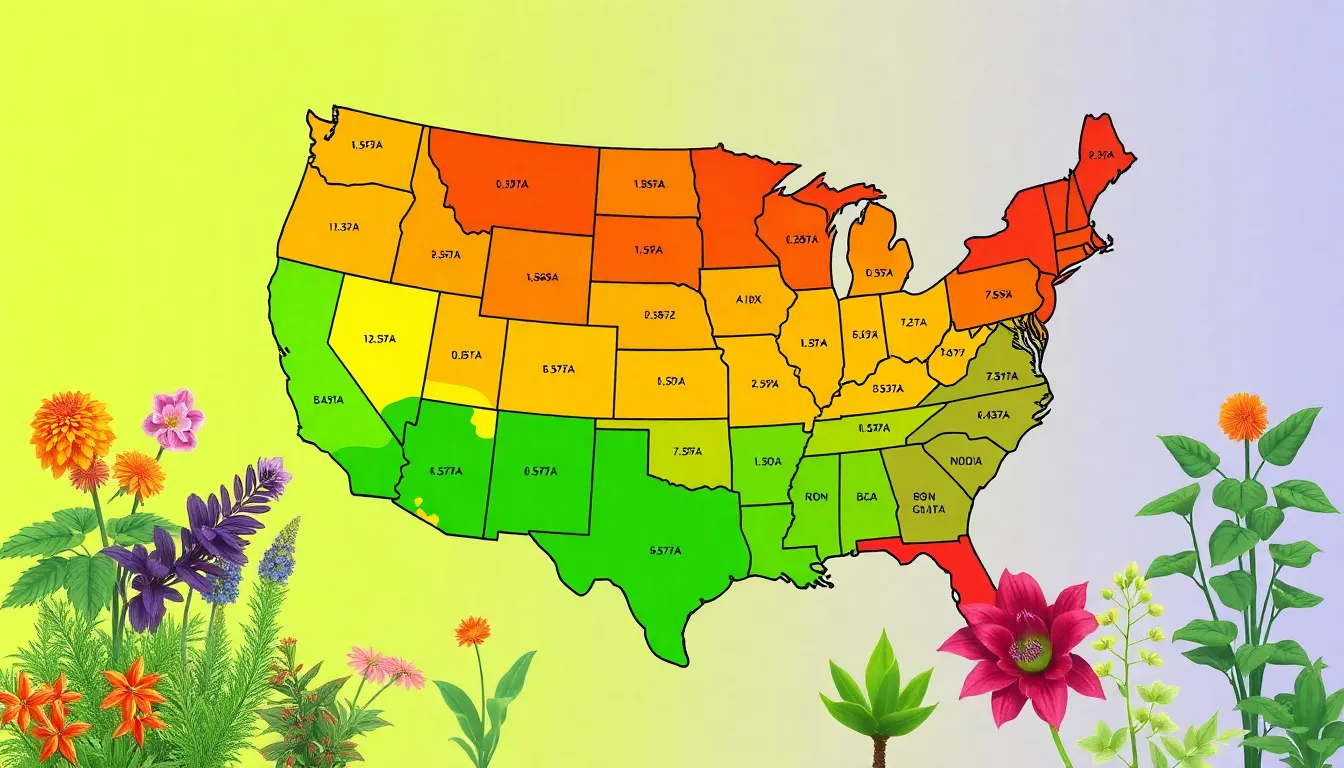Every gardener knows that not all plants are created equal. Some thrive in the sun while others prefer the shade, and some just can’t handle the cold like that one friend who always complains about winter. Understanding gardening zones is the secret sauce to cultivating a thriving garden that won’t wilt at the first sign of frost.
Gardening zones, determined by climate and temperature ranges, are like a VIP pass for plants. They help gardeners choose the right flora for their specific environment. So if you’ve ever wondered why your neighbor’s roses look like they just stepped off a magazine cover while yours resemble a sad, wilted salad, it might be time to dig into the world of gardening zones. With the right knowledge, anyone can turn their garden into a flourishing paradise.
Table of Contents
ToggleUnderstanding Gardening Zones
Gardening zones represent specific areas where plants thrive based on climate and temperature. Knowing these zones enables gardeners to select suitable plants for their environment.
What Are Gardening Zones?
Gardening zones classify regions by their hardiness, typically using the USDA Hardiness Zone map. Each zone corresponds to a range of average minimum temperatures. Zones range from 1 to 13, covering diverse climates across the United States. While Zone 1 experiences temperatures as low as -60°F, Zone 13 can reach minimums of 60°F. Gardeners can look at these zones to choose plants adapted to their local climate.
Importance of Gardening Zones
Understanding gardening zones aids in successful plant selection and cultivation. Selecting plants based on the appropriate zone increases the chances of growth and blooms. Some plants require warm temperatures, while others thrive in cooler conditions. By following zone guidelines, gardeners minimize the risk of plant loss due to temperature extremes. Knowledge of zones also fosters a more productive and vibrant garden landscape.
The USDA Plant Hardiness Zone Map

The USDA Plant Hardiness Zone Map serves as a critical resource for gardeners. It divides the United States into 13 zones based on average minimum temperatures.
Overview of the USDA Map
Zones on the USDA map range from 1 to 13. Zone 1 experiences minimum temperatures below -60°F, while Zone 13 sees temperatures above 60°F. This classification helps determine which plants are likely to thrive in specific climates. Each zone’s distinct temperature range allows gardeners to choose plants suited to their local weather conditions. By understanding these zones, individuals can make informed decisions about their gardening practices.
How to Use the USDA Map
Using the USDA map involves identifying the zone for your location. Gardeners can find their zone by entering their zip code on interactive maps available online. Once the zone is determined, selecting plants becomes easier. Look for plants labeled with a hardiness zone that includes your specific zone. If a plant thrives in multiple zones, it’s likely to adapt better to your local climate. Additionally, considering microclimates, such as sheltered areas or those exposed to direct sunlight, can further enhance gardening success.
Factors Influencing Gardening Zones
Understanding the factors that influence gardening zones helps gardeners make informed decisions. Climate conditions and geographical features play significant roles in zone classification.
Climate Conditions
Temperature, precipitation, and humidity define climate conditions, directly impacting plant survival. Warmer climates support a broader range of vegetation, while colder climates limit choices. Regions with higher annual rainfall often allow for lush gardens, but excessive moisture can lead to root rot. Periods of frost significantly affect growth cycles, as plants in the frost-free season flourish. For instance, tropical zones encourage year-round growth, but temperate zones see seasonal changes. By considering local climate variations, gardeners can select plants that better suit their environment.
Elevation and Topography
Elevation impacts temperature and sunlight exposure, influencing local gardening zones. Higher altitudes typically experience cooler temperatures, making it crucial for gardeners to adjust their plant selections accordingly. Slopes may lead to variations in sun exposure, with south-facing slopes receiving more light than north-facing ones. Areas with diverse topography can develop microclimates that create unique growing conditions. Additionally, wind patterns often shift due to terrain, affecting moisture retention in plants. A comprehensive understanding of elevation and topography empowers gardeners to optimize their gardening choices.
Choosing Plants for Your Gardening Zone
Understanding plant hardiness plays a crucial role in gardening success. Specific plants thrive only within certain USDA hardiness zones. For example, Zone 5 can support plants like peonies and hostas, while Zone 9 allows for tropical varieties like hibiscus and bougainvillea. Gardeners should evaluate their zone zip code to ensure they select plants capable of thriving in their climate. Additionally, local conditions, including microclimates, can influence plant choice.
Seasonal planting tips enhance garden productivity. Timing can impact plant establishment and growth. Early spring proves ideal for cool-weather crops such as lettuce and radishes. In contrast, warm-weather crops like tomatoes and peppers flourish when planted after the final frost. Observing local frost dates helps determine the right planting times. Regularly monitoring soil temperature aids in ensuring optimal germination conditions for selected plants.
Common Gardening Zones and Their Characteristics
Understanding gardening zones helps gardeners select appropriate plants. These zones classify regions based on climate and temperature, guiding gardeners in cultivating healthier gardens.
Zone 1 to 5
Zone 1 includes areas with extreme cold, where temperatures drop below -60°F. Zone 2 experiences minimums of -50°F to -40°F, while Zone 3 sees slightly warmer conditions, ranging from -40°F to -30°F. Zone 4, with temperatures between -30°F and -20°F, suits hardy plants. Zone 5 supports peonies and hostas, as temperatures range from -20°F to -10°F. These zones indicate that understanding local conditions maximizes plant success, especially for colder climates.
Zone 6 to 10
Zone 6 experiences milder winters, with temperatures from -10°F to 0°F. In Zone 7, plants thrive between 0°F and 10°F, making it ideal for diverse vegetation. Zone 8, with a range of 10°F to 20°F, accommodates plants like azaleas and camellias. Zone 9 encompasses temperatures from 20°F to 30°F, supporting warm-weather varieties like hibiscus. Finally, Zone 10, with temperatures above 30°F, is perfect for tropical plants such as bougainvillea, illustrating how warmer environments enhance plant variety.
Understanding gardening zones is essential for any gardener aiming to cultivate a thriving garden. By recognizing the specific climate and temperature conditions of their zone, gardeners can make informed choices about which plants to grow. This knowledge not only enhances the chances of successful growth but also minimizes the risk of plant loss due to unfavorable conditions.
Utilizing resources like the USDA Plant Hardiness Zone Map allows gardeners to easily identify their zone and select plants that will flourish in their environment. Ultimately, embracing the concept of gardening zones leads to a more vibrant and productive garden, showcasing the beauty of well-chosen plants that thrive in harmony with their surroundings.



